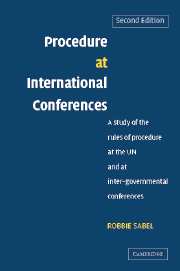 Procedure at International Conferences
Procedure at International Conferences Book contents
- Frontmatter
- Contents
- Preface to the second edition
- List of abbreviations and conference references
- Introduction
- 1 Historical development of rules of procedure of conferences and attempts to establish model rules
- 2 Adoption of rules of procedure
- 3 Rules of procedure and international law
- 4 Invitations, participation and credentials
- 5 Presiding officer and other officers of the conference
- 6 Meetings
- 7 Statements by delegations
- 8 Submission of proposals
- 9 Adjournment and closure of debate
- 10 Amendments
- 11 Withdrawal and reconsideration of motions
- 12 Procedural motions and points of order
- 13 Priorities between different proposals
- 14 Decision taking and method of voting
- 15 Majority required
- 16 Consensus
- 17 Separate votes
- 18 Conduct of voting – interruption of voting and correction of vote
- 19 Languages, records and documents
- 20 Committees
- 21 Suspension and amendment of rules of procedure
- Bibliography
- Index
8 - Submission of proposals
Published online by Cambridge University Press: 22 July 2009
- Frontmatter
- Contents
- Preface to the second edition
- List of abbreviations and conference references
- Introduction
- 1 Historical development of rules of procedure of conferences and attempts to establish model rules
- 2 Adoption of rules of procedure
- 3 Rules of procedure and international law
- 4 Invitations, participation and credentials
- 5 Presiding officer and other officers of the conference
- 6 Meetings
- 7 Statements by delegations
- 8 Submission of proposals
- 9 Adjournment and closure of debate
- 10 Amendments
- 11 Withdrawal and reconsideration of motions
- 12 Procedural motions and points of order
- 13 Priorities between different proposals
- 14 Decision taking and method of voting
- 15 Majority required
- 16 Consensus
- 17 Separate votes
- 18 Conduct of voting – interruption of voting and correction of vote
- 19 Languages, records and documents
- 20 Committees
- 21 Suspension and amendment of rules of procedure
- Bibliography
- Index
Summary
The difference between proposals and motions
The term ‘motion’ denotes that the conference is being requested to take action; the action being requested could be either procedural or substantive. The term ‘proposal’ usually refers to that part of the motion that contains the text proposed by a delegation in its motion.
The Legal Adviser to the UN has pointed out that ‘the word “amendment” had a meaning distinct from that of the word “proposal”; only the word “motion” embraced both at one and the same time’. A proposed amendment to an existing proposal is by definition a ‘motion’ on which the conference is being asked to take action. Rule 90 of the UNGA rules of procedure states that: ‘A motion is considered an amendment to a proposal if it …’.
A debate took place at the 1965 UNGA as to whether the word ‘proposal’ includes an amendment. Those objecting to interpreting it as being included pointed out that in Rule 78 reference is made to ‘Proposals and amendments’; hence it can be deduced that they are separate terms. The results of the debate were inconclusive: however, a logical solution would dictate that the word ‘proposal’ includes an amendment, otherwise, for example, the rule on reconsideration would not apply to amendments. The UN Model Rules avoid such possible ambiguity by stipulating in Rule 58(1) that: ‘A proposal is considered an amendment to another proposal …’ and ‘Unless specified otherwise, the word “proposal” in these rules shall be considered as including amendments.’
- Type
- Chapter
- Information
- Procedure at International ConferencesA Study of the Rules of Procedure at the UN and at Inter-governmental Conferences, pp. 145 - 176Publisher: Cambridge University PressPrint publication year: 2006


